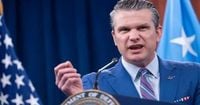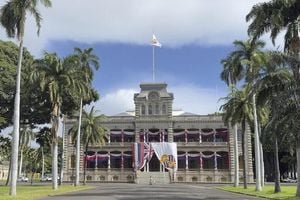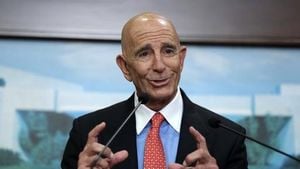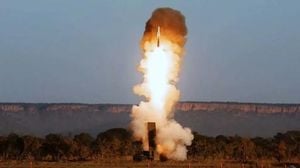Air Force Chief of Staff Gen. David W. Allvin is set to retire on or around November 1, 2025, ending his tenure after just two years—an unusually brief period for a position traditionally held for four. The announcement, made public on August 18, 2025, has sent ripples through military and political circles, raising questions about the reasons behind his early departure and the future direction of the U.S. Air Force.
Allvin’s decision comes at a pivotal moment for the service. According to Air & Space Forces Magazine, his retirement will mark the fourth-shortest term in the Air Force’s history, a fact that has not gone unnoticed. The release from the Air Force did not provide a reason for Allvin’s early exit but emphasized that he would continue to serve until a replacement is confirmed. This, officials say, is intended to allow for a smooth transition at the top of the nation’s aerial defense hierarchy.
In a statement posted to X (formerly Twitter), Allvin expressed gratitude for his time at the helm: “I’m grateful for the opportunity to serve as the 23rd Air Force Chief of Staff and I’m thankful for Secretary Meink, Secretary Hegseth, and President Trump’s faith in me to lead our service.” He added, “More than anything, I’m proud to have been part of the team of Airmen who live out our core values of integrity, service and excellence every day as we prepare to defend this great nation.”
Yet, the circumstances surrounding his retirement remain somewhat opaque. As Free Malaysia Today noted, it is unclear whether Allvin chose to retire or was asked to do so by Pentagon leaders, particularly Defense Secretary Pete Hegseth. The Office of the Secretary of Defense did not respond immediately to requests for comment, leaving speculation to swirl in the absence of an official explanation.
Allvin’s exit is just the latest in a series of high-profile personnel changes overseen by Hegseth since he assumed his post in January 2025. Hegseth has already dismissed several senior military officials, including the chairman of the Joint Chiefs of Staff, the head of the U.S. Navy, and the judge advocates general for the Army, Navy, and Air Force. This broader pattern of shakeups has led observers to wonder if Allvin’s departure is part of a larger strategy to reshape military leadership at the highest levels.
The Air Force, meanwhile, finds itself at a crossroads. In early 2024, service leaders unveiled a sweeping “re-optimization” initiative aimed at modernizing the force and preparing for future conflicts, particularly with an eye toward potential challenges posed by China. These modernization efforts, however, remain incomplete, and Allvin’s departure adds an additional layer of uncertainty to their future.
One of the most visible moments of Allvin’s tenure came earlier this year, when he stood alongside President Donald Trump in the Oval Office to unveil the new F-47 fighter jet. The event was intended to signal a new era of technological advancement and military readiness, but the broader transformation of the Air Force remains a work in progress.
At the same time, the service is still awaiting the confirmation of Gen. Thomas A. Bussiere as Vice Chief of Staff—a nomination made after the abrupt dismissal of Gen. James C. “Jim” Slife earlier in 2025. For the past six months, Lt. Gen. Scott L. Pleus, the staff director at Air Force headquarters, has been filling in as needed to perform the duties of Vice Chief. The leadership shuffle underscores just how unsettled the upper echelons of the Air Force have become in recent months.
The timing of Allvin’s retirement also presents logistical challenges. With just over two months left before his planned departure, the White House must move quickly to nominate a successor, and the Senate will need to hold confirmation hearings and a floor vote. This comes as Congress is already deep in negotiations over the 2026 defense spending and policy bills, which include at least $185 billion in discretionary funds earmarked for the Air Force. The prospect of leadership uncertainty at such a critical juncture has some lawmakers and defense analysts concerned about the potential for delays or disruptions to key initiatives.
Despite the uncertainty, Allvin’s contributions have not gone unrecognized. Secretary of the Air Force Troy E. Meink offered high praise for the outgoing chief, stating, “The Air Force is fortunate to have leaders like General Dave Allvin. During his tenure, the Air Force has undertaken transformational initiatives that will enable Airmen to answer their nation’s call for decades to come. General Allvin has been instrumental in my onboarding as the department’s 27th Secretary and I’m forever grateful for his partnership as well as his decades of exemplary service to our nation.”
Chief Master Sergeant of the Air Force David A. Flosi also took to social media to thank Allvin, writing, “Thank you for your nearly 40 years of dedication to our Airmen and Air Force. Congratulations, sir. I know you will continue to support our Airmen and the mission.”
Retired Lt. Gen. Burt M. Field, president and CEO of the Air & Space Forces Association, echoed these sentiments. “The Air & Space Forces Association salutes Gen. David W. Allvin for nearly four decades of exemplary service. His leadership at every level has been superb, and he has made a very positive difference in our Air Force. We wish him well in his future endeavors. We at AFA look forward to the nomination of a new Chief and the essential modernization of our Air Force.”
Allvin’s career has spanned nearly four decades, during which he has risen through the ranks and played a key role in shaping the Air Force’s strategic direction. His leadership during a period of significant transition, both within the service and in the broader context of U.S. defense policy, has earned him widespread respect among colleagues and subordinates alike.
Still, questions linger about what prompted his early retirement. While some suggest it may be part of a broader effort by Defense Secretary Hegseth to install new leadership across the military branches, others point to the immense pressures and challenges facing the Air Force as it seeks to modernize and adapt to a rapidly changing global security environment. Whatever the cause, the fact remains that the Air Force will soon need to chart a new course under fresh leadership.
As the service prepares for this transition, all eyes will be on the White House and Senate to see who will be tapped to lead the Air Force into its next chapter. With modernization efforts still underway, a new fighter jet just unveiled, and global threats on the horizon, the stakes could hardly be higher. The coming months promise to be a defining period for America’s air power—and for the men and women who serve beneath its banner.




